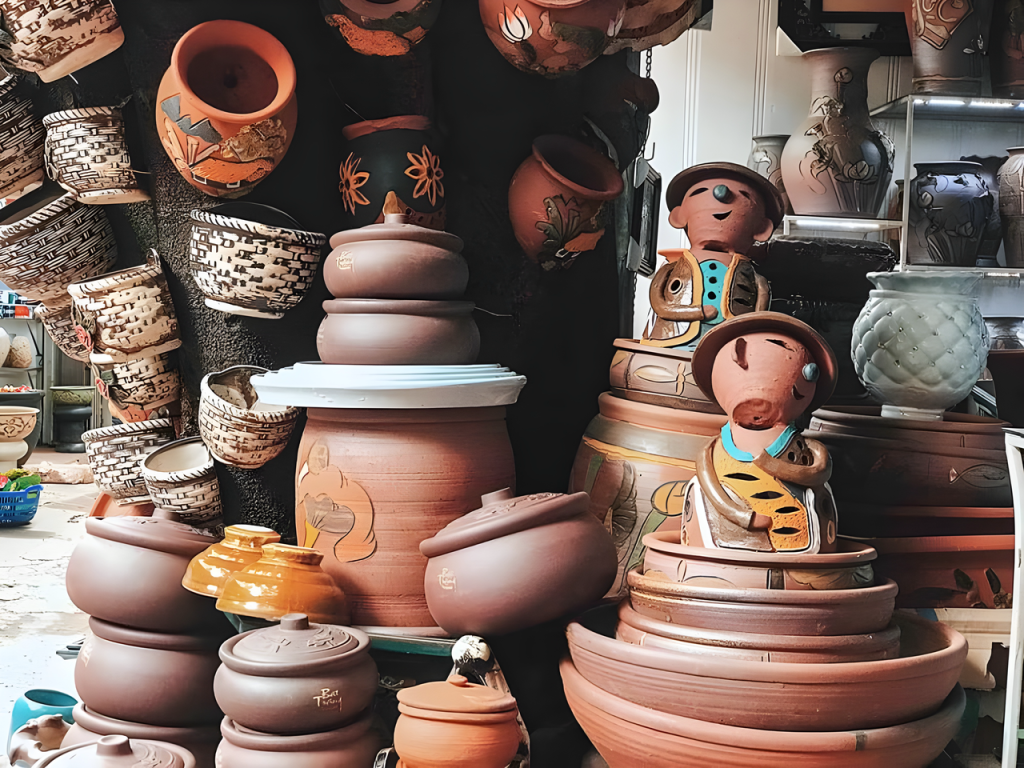Perched along the Red River, just 13 km southeast of Hanoi, Bat Trang pottery village is a shining star in Vietnam’s cultural constellation. With over 700 years of history under its belt, Bat Trang isn’t just a hub for ceramics; it’s a cultural hotspot that lures visitors from every nook and cranny.

1. The Origins and Legacy of Bat Trang Pottery Village
Bat Trang’s story goes way back to the 14th century, during the Ly Dynasty. The village sprang to life when artisans from Bo Bat village in Ninh Binh packed up their bags and set up shop here, bringing their pottery know-how with them. Thanks to its prime location by the Red River, Bat Trang quickly became a cornerstone of ceramic production, earning the nickname “pottery land.” Despite weathering many storms over the centuries, Bat Trang has managed to keep the flame of its ceramic tradition burning bright.

2. The Art of Pottery-Making at Bat Trang
Crafting Bat Trang pottery is no walk in the park. It involves a meticulous process where each step adds a pinch of magic to the final product.
Selecting the Clay: The artisans sift through clay, often from nearby Phu Lang and Dong Trieu, ensuring only the cream of the crop makes it into their creations.
- Shaping: The clay is molded into everything from everyday essentials like bowls and plates to ornate vases and sculptures. Each piece is a labor of love that reflects the skill and creativity of the craftsmen.
- Glazing: After shaping, the pottery gets dressed in a glaze that ranges from crisp white to vibrant greens, blues, and reddish-browns, giving each item its own unique flair.
- Firing: The final touch is firing the pottery at temperatures between 1200 and 1300 degrees Celsius. This step can be done in traditional charcoal kilns or modern gas kilns, depending on the desired result.

3. The Rich Tapestry of Bat Trang Pottery
Bat Trang is a goldmine of ceramic products, each piece showcasing the village’s rich artistic heritage.
- Cracked Glaze Ceramics: Known for their distinctive cracked glaze patterns, these pieces have an antique charm that’s second to none.
- Blue Glazed Ceramics: These ceramics, with their eye-catching blue glaze, often feature traditional designs such as lotus flowers and mythical creatures, reflecting Vietnam’s deep cultural roots.
- Relief Pattern Ceramics: Adorned with intricate relief patterns, these pieces are true showstoppers and add a touch of elegance to any collection.

4. Immersing Yourself in Bat Trang Pottery Village
Bat Trang is not just a place to shop but also a cultural experience that’s well worth your while. Visitors can dive into various hands-on activities and get a taste of the intricate world of pottery.
- Exploring Pottery Workshops: Visitors get a front-row seat to the pottery-making process, from shaping the clay to the final firing.
- Hands-on Pottery Experience: This popular activity lets visitors, especially families and young people, roll up their sleeves and create their own pottery under the expert eye of skilled artisans.
- Bat Trang Market: The bustling market is a treasure trove of ceramic goods, offering everything from simple pieces to elaborate creations, making it a prime spot for picking up unique items at reasonable prices.

5. Keeping the Pottery Craft Alive
In today’s fast-paced world, Bat Trang faces stiff competition from mass-produced goods, but it continues to thrive thanks to the unwavering dedication of its artisans and local support. Many young craftsmen have returned to the village, blending traditional techniques with modern twists. Additionally, the rise of experiential tourism helps keep Bat Trang’s rich heritage front and center.
Conclusion
Bat Trang pottery village is more than just a destination; it’s a living testament to Vietnam’s rich cultural heritage. Visiting Bat Trang offers a golden opportunity to marvel at beautiful ceramics and get a deeper understanding of this time-honored craft. It’s a must-see for anyone looking to experience Vietnam’s traditional artistry firsthand.






